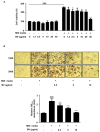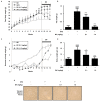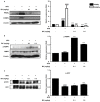Bee Venom Suppresses the Differentiation of Preadipocytes and High Fat Diet-Induced Obesity by Inhibiting Adipogenesis
- PMID: 29295544
- PMCID: PMC5793096
- DOI: 10.3390/toxins10010009
Bee Venom Suppresses the Differentiation of Preadipocytes and High Fat Diet-Induced Obesity by Inhibiting Adipogenesis
Abstract
Bee venom (BV) has been widely used in the treatment of certain immune-related diseases. It has been used for pain relief and in the treatment of chronic inflammatory diseases. Despite its extensive use, there is little documented evidence to demonstrate its medicinal utility against obesity. In this study, we demonstrated the inhibitory effects of BV on adipocyte differentiation in 3T3-L1 cells and on a high fat diet (HFD)-induced obesity mouse model through the inhibition of adipogenesis. BV inhibited lipid accumulation, visualized by Oil Red O staining, without cytotoxicity in the 3T3-L1 cells. Male C57BL/6 mice were fed either a HFD or a control diet for 8 weeks, and BV (0.1 mg/kg or 1 mg/kg) or saline was injected during the last 4 weeks. BV-treated mice showed a reduced body weight gain. BV was shown to inhibit adipogenesis by downregulating the expression of the transcription factors CCAAT/enhancer-binding proteins (C/EBPs) and the peroxisome proliferator-activated receptor gamma (PPARγ), using RT-qPCR and Western blotting. BV induced the phosphorylation of AMP-activated kinase (AMPK) and acetyl-CoA carboxylase (ACC) in the cell line and in obese mice. These findings demonstrate that BV mediates anti-obesity/differentiation effects by suppressing obesity-related transcription factors.
Keywords: AMPK; Bee venom; MAPK; PPARγ; adipogenesis.
Conflict of interest statement
The authors have no conflict of interest to declare.
Figures





Similar articles
-
5,7-Dimethoxyflavone Attenuates Obesity by Inhibiting Adipogenesis in 3T3-L1 Adipocytes and High-Fat Diet-Induced Obese C57BL/6J Mice.J Med Food. 2016 Dec;19(12):1111-1119. doi: 10.1089/jmf.2016.3800. Epub 2016 Nov 9. J Med Food. 2016. PMID: 27828718
-
Fermented Platycodon grandiflorum Extract Inhibits Lipid Accumulation in 3T3-L1 Adipocytes and High-Fat Diet-Induced Obese Mice.J Med Food. 2016 Nov;19(11):1004-1014. doi: 10.1089/jmf.2016.3805. Epub 2016 Oct 28. J Med Food. 2016. PMID: 27792464
-
Ramalin inhibits differentiation of 3T3-L1 preadipocytes and suppresses adiposity and body weight in a high-fat diet-fed C57BL/6J mice.Chem Biol Interact. 2016 Sep 25;257:71-80. doi: 10.1016/j.cbi.2016.07.034. Epub 2016 Jul 30. Chem Biol Interact. 2016. PMID: 27481193
-
Natural Dietary and Herbal Products in Anti-Obesity Treatment.Molecules. 2016 Oct 11;21(10):1351. doi: 10.3390/molecules21101351. Molecules. 2016. PMID: 27727194 Free PMC article. Review.
-
Potential Therapeutic Applications of Bee Venom on Skin Disease and Its Mechanisms: A Literature Review.Toxins (Basel). 2019 Jun 27;11(7):374. doi: 10.3390/toxins11070374. Toxins (Basel). 2019. PMID: 31252651 Free PMC article. Review.
Cited by
-
Melittin from Bee Venom Encapsulating Electrospun Fibers as a Potential Antimicrobial Wound Dressing Patches for Skin Infections.Pharmaceutics. 2022 Mar 28;14(4):725. doi: 10.3390/pharmaceutics14040725. Pharmaceutics. 2022. PMID: 35456558 Free PMC article.
-
Bothrops moojeni snake venom induces an inflammatory response in preadipocytes: Insights into a new aspect of envenomation.PLoS Negl Trop Dis. 2022 Aug 8;16(8):e0010658. doi: 10.1371/journal.pntd.0010658. eCollection 2022 Aug. PLoS Negl Trop Dis. 2022. PMID: 35939519 Free PMC article.
-
Toxins in Drug Discovery and Pharmacology.Toxins (Basel). 2018 Mar 16;10(3):126. doi: 10.3390/toxins10030126. Toxins (Basel). 2018. PMID: 29547537 Free PMC article.
-
A novel peptide RIFV suppresses human adipocyte differentiation through the inhibition of C/EBP-β expression.Nutr Metab (Lond). 2019 Dec 23;16:88. doi: 10.1186/s12986-019-0414-z. eCollection 2019. Nutr Metab (Lond). 2019. PMID: 31889968 Free PMC article.
-
Bee Venom: From Venom to Drug.Molecules. 2021 Aug 15;26(16):4941. doi: 10.3390/molecules26164941. Molecules. 2021. PMID: 34443529 Free PMC article. Review.
References
Publication types
MeSH terms
Substances
LinkOut - more resources
Full Text Sources
Other Literature Sources
Medical

